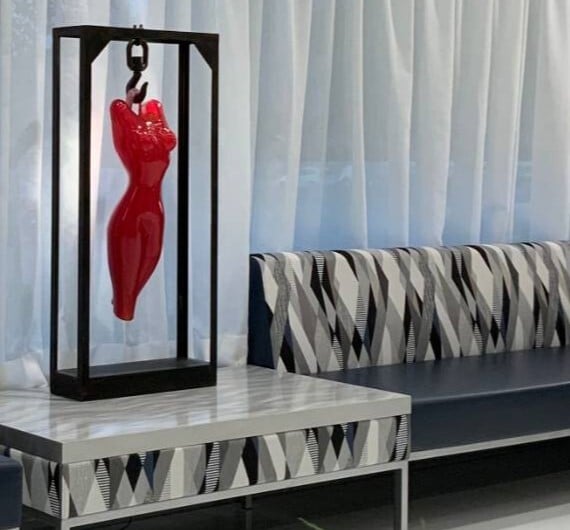*Individual results may vary
VASER/PAL Hi-Definition Lipo-Abdominoplasty
As if things have not been complicated enough to understand, I am throwing out another option to consider. To make things a little easier to understand from the outset, VASER/PAL HI-Definition Lipo-Abdominoplasty is simply VASER/PAL liposuction simultaneously coupled with an abdominoplasty. Therefore, all of the previously described techniques of abdominoplasty apply, with the addition that VASER/PAL liposuction is performed first.
COMBINING A TUMMY TUCK WITH LIPOSUCTION
Other Liposuction Procedures We Offer
- VASER Liposuction
VASER 4D Lipo/VASER Hi-Def - VASER Fat Transfer (Buttocks, Hips, Face)
- VASER for Men
Why 4D VASER/PAL Lipo-Abdominoplasty?
Why use VASER liposuction if you are having the excess fat and skin removed anyway with an abdominoplasty? Here is the explanation: During an abdominoplasty, the abdominal skin is elevated off the abdominal muscles, pulled down and excess skin and fat is removed from the lower portion of the skin flap. There is more to it than this, but this is a simplified explanation. For more info, see Abdominoplasty. The remaining abdominal skin is just as thick with fat as it was prior to the surgery. There is no longer an excess of abdominal skin, but the skin that remains has just as much fat under it as it did prior to surgery. Better contours are achieved by eliminating the redundancy of skin, and thus giving a tighter appearance to the abdomen. However, by not thinning the remaining skin, there will not be any improvement in muscular definition. Unless your skin is very thin and your muscles well developed, an abdominoplasty alone will give you a substantial improvement in contours but will be limited by the fact that the appearance will be very two dimensional – kind of like a sheet pulled flat down until taut*. If you have thin skin and a well developed musculature, then you can have more definition after an abdominoplasty naturally.
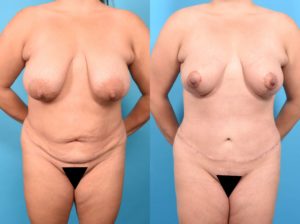
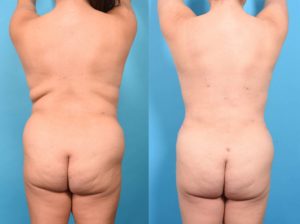
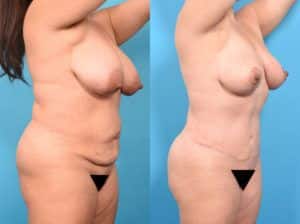
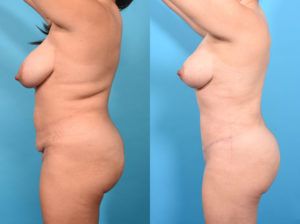
4D VASER/PAL Lipo-Abdominoplasty with Simultaneous Breast Reduction
This patient underwent circumferential VASER/PAL liposculpture with fat transfer to the buttocks. Next, a lipoabdominoplasty was performed with umbilical re-location. Finally, a breast reduction was performed. Note the following improvements that would not be possible without liposuction: narrow, defined waist with muscular definition, more pronounced S-curve along the back, elimination of back rolls under her bra, fuller, higher, rounder buttocks. BodyTite was used to maximize skin contraction on the back rolls.
Benefits of 4D VASER/PAL Lipo-Abdominoplasty
By performing 4D-VASER/PAL liposuction prior to abdominoplasty, the abdominal skin can be selectively thinned and shaped prior to abdominoplasty, leading to a more natural shape, with three dimensional contours, not just a flat panel of skin stretched down over the abdomen. In the vast majority of cases, VASER should be performed on the flanks as well, to better enhance the contours of the trunk as an aesthetic unit of the body. Otherwise, the abdomen can look flat and sculpted with blunted, rounded borders where the flanks remain unshaped. In some cases, adding VASER liposuction extended to the flanks may even permit a standard abdominoplasty to give good results where otherwise an extended abdominoplasty (excising skin around the sides of the flanks) would have otherwise been necessary.
To further enhance your results, you may wish to consider VASER liposuction of the back, arms, thighs, mons and fat transfer to the buttocks and hips. Just a thought…To see how treatment of all of these areas can enhance your results, please view the 4D VASER/PAL liposculpture photo gallery.
Prev Chapter: The Different Types of Abdominoplasty »
Next Chapter: The Recovery – The Way I Do It Now… »



